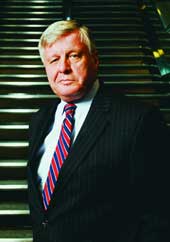Productivity by the dashboard light

EDS pursues growth through innovation, simplification

Jim Duffey, Vice President and General Manager of EDS' U.S. Public Sector Division
Proven methodology
EDS' productivity methodology measures information metrics, sorts them by importance and produces a series of actions.
The company supports the approach, said Jim Duffey, vice president and general manager of EDS' U.S. Public Sector division, which has more than 12,000 employees and $3 billion in annual revenue.
"It's very straightforward," Duffey said. "We use it on ourselves, we're using it with our current customers, and when we respond to [requests for proposals] we describe what we'll do as a differentiating value in the competition."
Duffey likened interactive visibility to the dashboard on a vehicle. "It lets you know whether or not the machine is doing what it's supposed to be doing," he said.
EDS used the dashboard as one of its selling points to win the $7 billion Navy-Marine Corps Intranet contract in 2000, said Herb Strauss, research vice president of national security at Gartner. NMCI was the biggest single contract ever awarded for government information technology services, but it was also rife with major problems, including computers that were incompatible with other systems and databases, and a variety of software applications, some of them unique to their base or ship.
"The CEO and senior executives of EDS would see the same performance indicators as the secretary of the Navy in terms of performance," Strauss said, describing how the contract was designed. But EDS had a dashboard with many indicators on it, he added. "What they needed to have was a more manageable executive dashboard that EDS and Navy leaders could focus on and have a better appreciation" for what was needed.
EDS continually improved the dashboard as the contract wore on, Strauss said.
Rittenmeyer said he believes that interactive visibility helps eliminate unnecessary steps and processes ? a demand stoked by today's world of instant communication ? and creates a more robust company or agency.
"You begin to look at organizations and revisit on a constant basis what work people are doing, and how does that work provide value to the customer," he said. "It's a systematic examination of processes one by one that applies also to individual job performance and appraisals."
Because much of EDS' work in the federal sector involves operating and maintaining existing systems, interactive visibility allows the client and the contractor to distinguish critical data from old data and code, which often are useless holdovers from outdated systems, Duffey said.
The patchwork of databases within government has also kept agencies from functioning at their best, and aversion to risk within some agencies tends to act as a brake on simplification and change, he added.
"We are [often] reading information that existed prior to the use of the dashboard, but was not brought to [the client's] attention so that you could actually do something about it," Duffey said. He added that pinpointing only the critical pieces of code and data allows you to modify, replace and adjust a system.
"You put all three of those together and you get yourself a better operating environment that is quicker, cheaper, more efficient [and] more productive," Duffey said.
Adding value
Simplification also means getting rid of the "that's-the-way-we-always-did-it" mentality and replacing repetitive, formula-driven human activities with automation. "On average, complexity adds no value. It just adds steps," he added. The airline industry's introduction of electronic ticketing and kiosks to print boarding passes is an example of simplification and automation that has worked well, Rittenmeyer said.
EDS was in the first wave of government outsourcing in the 1990s. "In fact, in national security they were probably the leading firm," Strauss said. But the company faced a number of major problems in the wake of the 2001 terrorist attacks and the bursting of the tech bubble.
The government unit "needed to focus on where they made the most money and where the government held them in high regard in making that money," Strauss said, and added that Duffey has added assertive leadership and has reorganized the federal business unit to deal with changes, especially in the defense market.
"All simplification needs to add value," Duffey said. You simplify because it reduces costs, increases quality, shortens the number of steps and eliminates the chances for error. "At the end of the day," he added, "technology ? as simple as you make it ? has to be as complex as is needed."
Associate Editor David Hubler can be reached at dhubler@1105govinfo.com.
NEXT STORY: Transformation man